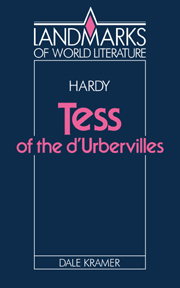3 - Some literary influences
Published online by Cambridge University Press: 05 June 2012
Summary
An essay on literary influences on a novel as rich as Tess can scarcely do more than touch on a few of the stronger or more interesting predecessors. The book crystallises the Victorian period in the way it brings into its point so much of its literary surroundings. And, of course, some things we may think of as ‘influences’ may be nothing more than similar responses by Hardy and other writers to similar information and attitudes.
Chastity in nineteenth–century life and writing
One of these areas is certainly that of sexual morality in life and fiction, including Tess. It is commonly stated that Victorians shied away from direct mention of sexual life, yet nearly every Victorian novel is founded to a greater or lesser extent exactly upon the question of ‘given the man and woman, how to find a basis for their sexual relation’, as Hardy defined it in the Preface to The Woodlanders. Novels were selected for publication in mass-circulation magazines on the criterion that they could be read in rural parsonages to young daughters – a standard which several of Hardy's novels did not meet, according to letters from the parson fathers which have survived in publishers' archives. Yet, in many of the same rural districts served by the parsons, conditions in the farm workers' two-room homes were so crowded that, as church boards declared, immorality (by which here they meant incest) was almost inevitable.
- Type
- Chapter
- Information
- Hardy: Tess of the D'Urbervilles , pp. 25 - 32Publisher: Cambridge University PressPrint publication year: 1991



